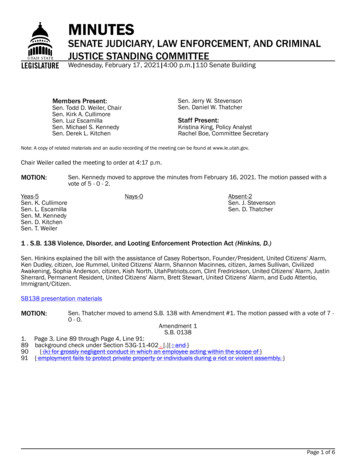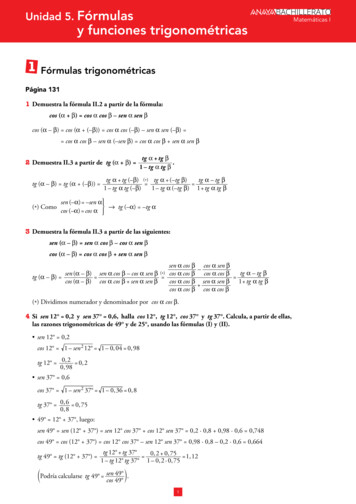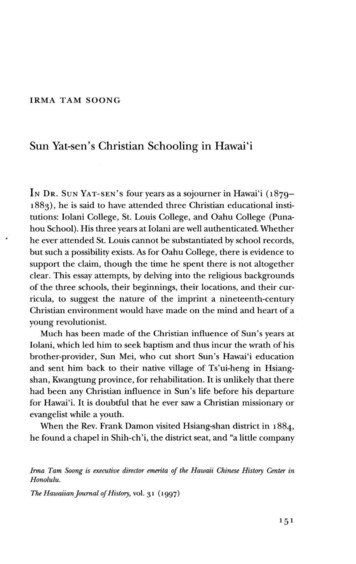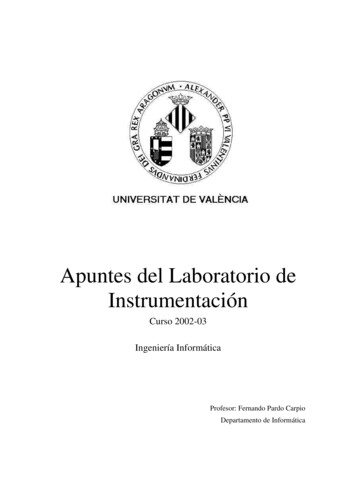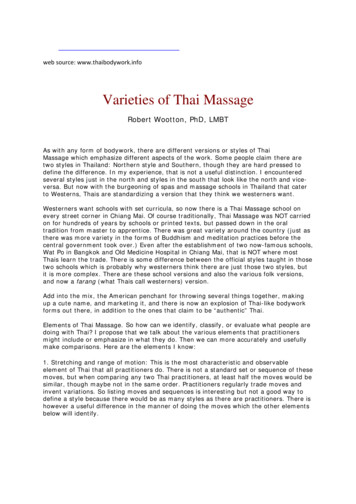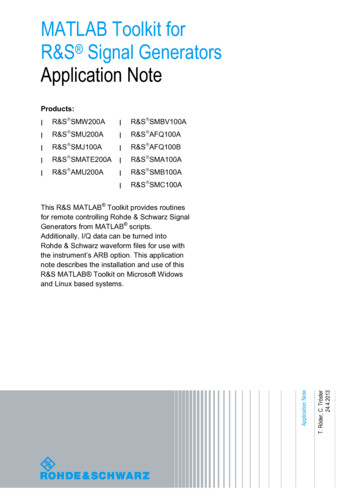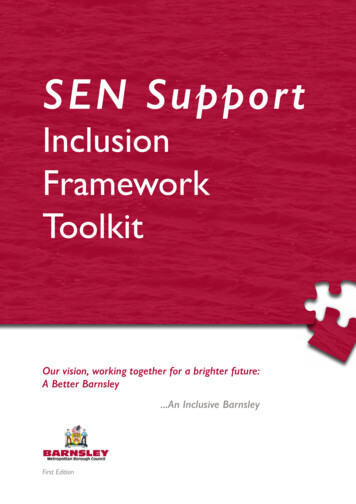
Transcription
SEN SupportInclusionFrameworkToolkitOur vision, working together for a brighter future:A Better Barnsley.An Inclusive BarnsleyFirst Edition
SEN SupportInclusion Framework ToolkitFirst EditionBarnsley Inclusion Development SENDCO TeamBev BradleyBen Froggatt
“ I’m delighted to introduce this Inclusion Framework Toolkit which represents how a graduated responseto SEND within schools can help ensure good and improving outcomes for all pupils. The toolkit is theresult of much hard work of many people drawn from across a range of schools in Barnsley. It has beenco-produced with professionals including SENDCOs and Head Teachers, specialist staff and parentsand carers of children with SEND. I am very grateful to all of those involved for the time and effortthey have given to ensure the toolkit is of the highest quality.I would particularly like to thank Bev Bradley and Ben Froggatt for the passion and commitment theyhave demonstrated in leading the work to develop the toolkit. Thanks also must go to Tamara GulliverHead Teacher, The Mill Academy , Melanie Priestley CEO St Mary’s Academy Trust and Julie Allen,Head Teacher Birkwood Primary School for supporting Bev and Ben to undertake this work on behalfof the Barnsley borough. This has been a truly collaborative piece of work, reflecting our determinationto support sector-led school improvement for the benefit of all our children and families.I hope you find this toolkit helpful and look forward to seeing outcomes continue to improve for pupilswith SEND in Barnsley. ”Mel John-RossExecutive Director, Children’s Services
ForewordTo our Headteachers, Teachers and SENDCOs.Excellent teaching for pupils with SEND is excellent teaching for all. The Code of Practiceemphasises that high quality teaching, differentiated for individual pupils, is the first step inresponding to pupils who have or may have SEND.This is the responsibility of the class teacher,led by the SENDCO and Headteacher. Additional intervention and support cannot compensatefor a lack of good quality teaching. High quality provision to meet the needs of children andyoung people with SEND includes the use of evidence-based interventions and approaches.Educational settings, joint commissioning arrangements and local authorities are thereforeresponsible for accessing the best evidence available on interventions and approaches tosupport children and young people.As you read this framework, consider: All children and young people who have special education needs or a disability shouldhave their needs met.The child/young person and their family should be placed at the centre of thisprocess; their views and wishes should be taken into account.All children and young people who have special educational needs should receive abroad, well balanced and relevant education at all ages.School Focussed Plans (SFP) and Education, Health and care Plans (EHCP) are uniqueto the individual learner and reflect their strengths and aspirations.Outcomes and targets must be set so that they impact positively on progress inorder to be considered effective.This is a framework, written by Barnsley Inclusion Development SENDCO Team, that equipsteachers with high quality tools to identify and support children and young people with SEND,covering Quality First Teaching and SEN Support.The vision shown overleaf is the basis on which this framework is built.With support, your Inclusion Development Team,Bev BradleyBen Froggatt
Acknowledgementswith thanks to.The compilation of this Inclusion Toolkit would not have been possible without the contributionsand commitment from the following individuals and teams:Barnsley Education Inclusion ServicesEducation Child and Community Psychology (ECCP) ServiceHabilitation TeamHearing Support and Vision Support ServiceSocial Communication and Interaction (SCI) ServiceChildren’s Therapy ServicesChildren’s Speech and Language TherapyOccupational TherapyPhysiotherapyBarnsley EHC TeamWorking Party ProfessionalsAlex Taylor,Youth Voice and Participation CoordinatorLaura Hammerton, Service and Strategy Manager Early YearsLyn Dixon, Inclusion Development Leader at Churchfield Primary SchoolTracy Letchford, Service Manager 0-19 Public Health NursingSpecialist Provision ConsultantsHannah Williams, Greenacre SchoolLuke Mitchell, Springwell Community School and Positive RegardSharon Wainwright, Greenacre SchoolParent Consultation GroupEmma Speed, ParentJenny Holmes, ParentPaula Morley, Foster Carerwith special thanks to.Joe Bradley, for providing creative support
Working Party SENDCOsAmy Webster, Carlton Primary AcademyAmy Whitehead, Summerfields Primary AcademyCharlotte Farrell, Keresforth Primary SchoolCharlotte Searle, Lacewood Primary SchoolDonna Evans, Greenfield Primary SchoolDonna Hill, Netherwood AcademyDuncan Grayhurst,The Ellis C E Primary SchoolGeorgina Cooper, Jump Primary SchoolHelen Jones,Ward Green Primary SchoolHelen Rolling, Oxspring Primary SchoolHelena Lockwood, Meadstead Primary SchoolJade Gisby, Carlton Outwood AcademyJan Hutchinson, Cawthorne Primary SchoolJeannette Stratton, Headteacher at Lacewood Primary SchoolJoanne Gibbons, Oakhill AcademyKate Joblin,West Meadows Primary SchoolKatie Anson, Lacewood Primary SchoolKatie Hirst, Upperwood AcademyKaty Haverty, Parkside Primary SchoolLaura Broomhead, Barugh Green Primary SchoolLaura Wakefield, Summerfields Primary SchoolLindsey Waugh, Hoyland Springwood Primary SchoolLisa Windsor, Burton Road Primary SchoolLynn Hoyland, Kirk Balk AcademyRachel Parish, All Saints AcademyRachael Smith, Gawber Primary SchoolSarah Foster, Penistone St Johns Primary SchoolSue Gilroy, Shawlands Primary School7
Inclusion is a mindset. It is not a wayof thinking. It is not a programmethat we run or a classroom in ourschool or a favour that we do forsomeone.Inclusion is who we are. It is whowe must strive to be.- Lisa Friedman (2015)
The VisionHow the Inclusion Development Team will supportSENDCOs across Barnsley:Additional to/different fromProvision mappingIdentifyingvulnerable groupsInclusive practiceCo-productionProvision mappingDocuments: SFP/EHCP/ARBuilding relationshipsIntentionProvision-led achingMonitoring & ReviewingSEND SupportFramProvision mappingNetwork of knowledgeworkImpacteFunded SEN supportNeeds metIn c lu sio uccessful outcomesOfsted (2019) The Education Inspection Framework.Available at; t/uploads/system/uploads/attachment data/file/801429/Education inspection framework.pdf
ContentsForewordAcknowledgementsThe VisionVolume 1The SENDCOThe Role of the SENDCOThe Key Responsibilities of the SENDCO151617All Teachers are Teachers of SENDWorking with FamiliesWorking with other Professionals192123The Code of PracticePrinciples and RequirementsKey Points from the Code of Practice252525Identifying SEN in Schools26Quality First Teaching (QFT)What does Quality First Teaching Look Like?How can Inclusive Quality First Teaching Promote Achievements?Teaching Assistants28282929A Graduated Approach to SENDThe Three Elements3032Early Help Assessment (EHA)What is Early Help?Our Local ApproachEarly Help Assessment34343435Voice of the Child37SEND Support in Schools39Assess, Plan, Do and Review (APDR)40OutcomesCognition and Learning exampleSocial, Emotional and Mental Health exampleCommunication and Interaction examplePhysical and Sensory example4347474949
The Outcome Sandwich51Provision Mapping and Funding52The Notional Budget55The School Focussed Plan (SFP)Sections within the SFPUpdating and Reviewing575859Successful Preparation for Adulthood61Safeguarding63Volume 2The Four Broad Areas of Need67Volume Two ‘User Guide’69Cognition and Learning (Assess, Plan, Do, Review)Element One: Quality First Teaching - Universal ApproachElement Two: SEN Support - Targeted Approach717383Social, Emotional and Mental Health Difficulties (Assess, Plan, Do, Review)Element One: Quality First Teaching - Universal ApproachElement Two: SEN Support - Targeted Approach9395105Communication and Interaction (Assess, Plan, Do, Review)Element One: Quality First Teaching - Universal ApproachElement Two: SEN Support - Targeted Approach115117127Physical and Sensory - Deafness and Hearing Loss & Vision Loss (Assess, Plan, Do, Review)Element One: Quality First Teaching - Universal ApproachElement Two: SEN Support - Targeted Approach137139149Physical and Sensory - Physical Needs & Sensory Processing Difficulties (Assess, Plan, Do, Review)Element One: Quality First Teaching - Universal ApproachElement Two: SEN Support - Targeted Approach159161171“Everybody is a genius”181Acronyms18213
Volume OneThe Knowledge: SEND in Schools
115
Meeting StatutoryRequirementsIdentifying andassessing needsImplementing SENDpolicy and practiceMonitoring andevaluating provisionFulfilling keyresponsibilities
The SENDCO:Special Educational Needs (SEN)A child or young person has SEN if they have a learning difficulty or disabilitywhich calls for special educational provision to be made for him or her.A child of compulsory school age or a young person has a learning difficulty or disability if heor she; Has a significantly greater difficulty in learning than the majority of others of the sameage, or Has a disability which prevents or hinders him or her from making use of facilities of akind generally provided for others of the same age in mainstream schools or mainstreampost-16 settings.For children aged two or more, special educational provision is educational or training provisionthat is additional to or different from that made generally for other children or young people ofthe same age by mainstream schools, maintained nursery schools, mainstream post-16 settingsor by relevant early years providers. For a child under two years of age, special educationalprovision means educational provision of any kind.For a child under two years of age, special educational provision means educational provisionof any kind.A child under compulsory school age has special educational needs if he or she is likely to fallwithin the definition in paragraph one above when they reach compulsory school age or woulddo so if special educational provision was not made for them (Section 20 Children and FamiliesAct 2014).Post-16 settings often use the term learning difficulties and disabilities (LDD).The term SEN isused in the Code of Practice across the 0-25 age range but includes LDD.Department for Education and Department of Health (2015) Specialeducational needs and disability code of practice: 0 to 25 years. Available -code-of-practice-0-to-2517
The Role of the SENDCO Involves: Ensuring all practitioners in the setting understand their responsibilities to children withSEN and the setting’s approach to identifying and meeting SEN. Advising and supporting colleagues. Ensuring parents are closely involved throughout and that their insights inform actiontaken by the setting. Liaising with professionals or agencies beyond the setting.Governing bodies of maintained mainstream schools and the proprietors of mainstreamacademy schools (including free schools) must ensure that there is a qualified teacher designatedas SENDCO for the school.The SENDCO must be a qualified teacher working at the school. A newly appointed SENDCOmust be a qualified teacher and, where they have not previously been the SENDCO at that orany other relevant school for a total period of more than twelve months, they must achieve aNational Award in Special Educational Needs Co-ordination within three years of appointment.A National Award must be a postgraduate course accredited by a recognised higher educationprovider. The National College for Teaching and Leadership has worked with providers todevelop a set of learning outcomes.When appointing staff or arranging for them to study fora National Award schools should satisfy themselves that the chosen course will meet theseoutcomes and equip the SENDCO to fulfil the duties outlined in this Code. Any selectedcourse should be at least equivalent to 60 credits at postgraduate study.The SENDCO has an important role to play with the head teacher and governing body, indetermining the strategic development of SEN policy and provision in the school.They will bemost effective in that role if they are part of the school leadership team.The SENDCO has day-to-day responsibility for the operation of SEN policy and co-ordinationof specific provision made to support individual pupils with SEN, including those who haveEHC plans.The SENDCO provides professional guidance to colleagues and will work closely with staff,parents and other agencies.The SENDCO should be aware of the provision in the Local Offerand be able to work with professionals providing a support role to families to ensure thatpupils with SEN receive appropriate support and high quality teaching.
The Key Responsibilities of the SENDCO may Include: Overseeing the day-to-day operation of the school’s SEN policy. Co-ordinating provision for children with SEN. Liaising with the relevant Designated Teacher where a looked after pupil has SEN. Advising on the graduated approach to providing SEN support. Liaising with parents of pupils with SEN. Liaising with early years providers, other schools, educational psychologists, health andsocial care professionals, and independent or voluntary bodies. Being a key point of contact with external agencies, especially the local authority and itssupport services. Liaising with potential next providers of education to ensure a pupil and their parentsare informed about options and a smooth transition is planned. Working with the head teacher and school governors to ensure that the schoolmeets its responsibilities under the Equality Act (2010) with regard to reasonableadjustments and access arrangements. Ensuring that the school keeps the records of all pupils with SEN up to date. Liaise with the young person, involve them in conversations and decisions to explainin an appropriate way the process involved with their support.The school should ensure that the SENDCO has sufficient time and resources to carry out thesefunctions.This should include providing the SENDCO with sufficient administrative support andtime away from teaching to enable them to fulfil their responsibilities in a similar way to otherimportant strategic roles within a school.It may be appropriate for a number of smaller primary schools to share a SENDCO employedto work across the individual schools, where they meet the other requirements set out in thischapter of the Code. Schools can consider this arrangement where it secures sufficient timeaway from teaching and sufficient administrative support to enable the SENDCO to fulfil the roleeffectively for the total registered pupil population across all of the schools involved.Where such a shared approach is taken the SENDCO should not normally have a significant classteaching commitment. Such a shared SENDCO role should not be carried out by a headteacherat one of the schools.Schools should review the effectiveness of such a shared SENDCO role regularly and should notpersist with it where there is evidence of a negative impact on the quality of SEN provision, orthe progress of pupils with SEN.Department for Education and Department of Health (2015)Special educational needs and disability code of practice: 0 to 25 years.19
The TeacherAn important cog in theSEND system.If all of the cogs do notwork in unison, the systemfails.
All Teachers are Teachers of SENDThe Teacher:All schools adhere to the policies set out in the SEND Code of Practice (2015).In this document,it clearly sets out that all teachers are teachers of pupils with special educational needs.SEN Support in SchoolsTeachers are responsible and accountable for the progress and development of the pupils intheir class, including where pupils access support from teaching assistants or specialist staff.High quality teaching, differentiated for individual pupils, is the first step in responding to pupilswho have or may have SEN.What Teachers Must doTeachers are both responsible and accountable for the progress and development of all pupilsin their class, including those pupils who access support from teaching assistants or specialiststaff.Where support staff work with pupils with SEN, the teacher has overall responsibility forthose pupils and must ensure that they make appropriate progress.What Teachers Should doThe Code of Practice says that every teacher is a teacher of SEN. It says that ‘class and subjectteachers, supported by the senior leadership team, should make regular assessments ofprogress for all pupils’.Where concerns are identified, teachers should work with the specialeducational needs co-ordinator (SENDCO) to assess whether the child has SEN.Teachers should set clear progress targets for all pupils with SEN that focus on ‘their potentialto achieve at or above expectation’.Schools must engage parents and young people in decisions about matters that relate totheir own or their child’s SEN, including how those needs should be met. Class teachers, inconsultation with the SENDCO, may be asked to hold regular meetings with parents to discusstheir child’s progress towards agreed outcomes.Teachers have Responsibilities: Directly to the Child or Young person (CYP) at risk of or with special educationalneeds/disabilities (e.g. identification, assessment, intervention, monitoring and review) Working with families and carers. Working with other professionals.21
Class and Subject Teachers Should.Ensure early identification of; Special Educational Needs.Barriers to learning.Appropriate interventions and actions (e.g. ‘graduated approach’, ‘SEN support’) inconsultation with the SENDCO.Class and Subject Teachers Should; Have full knowledge of the CYP’s SEN status including content on their support planssuch as support (School Focussed Plan -SFP) or Education, Health and Care Plans(EHCP).Provide access to a broad and balanced curriculum.Understand and provide ‘high quality teaching’.Have appropriate high expectations based on assessment.Be accountable for the CYPs learning, progress and development.Maintain responsibility for working with the CYP on a daily basis, even when interventionsinvolve group or personalised teaching/support away from the main class.Regularly assess, monitor and review their progress (academic, developmental andsocial-emotional) during the course of the year with a view to ensuring the ultimateoutcome of ‘a successful transition to adult life.’Through professional development, teachers should secure knowledge,understanding and skills around: Identification of specific special educational needs in the context of monitoring allpupils’ progress and development.Appropriate basic or advanced understanding of specific special educational needs/disabilities.Quality teaching for pupils with special educational needs.Class and subject teachers should apply the graduated approach tosuspected special educational needs in consultation with the SENDCO(and Designated Teacher if the pupil is ‘looked after’ by the local authority),parents/carers and young people. They should: Confirm delivery of quality first teaching.Identify evidence-based interventions related to the pupil’s apparent needs, implementthem strategically and evidence impact.Carry out a clear analysis of the pupil’s needs based on all available evidence (e.g. schooldocumentation of the pupil’s progress to date with reference to national and peergroup data)Use and reference Barnsley’s Local Offer and external agencies as necessary.
Working with FamiliesClass and Subject Teachers Must: Formally notify parents where it is decided to provide a pupil with ‘SEN support’,although parents and pupils should have already been involved in forming the initialassessment of needs.Contribute at least annually to an EHCP Annual Review where necessary.Class and Subject Teachers Should: Inform and involve parents/carers at the point of their and the SENDCO’s initialconcerns about a child/young person’s learning and possible special educational needs.Develop a positive dialogue with them around their child’s special educational needs,progress and outcomes.When a pupil is receiving SEN support, talk to parents regularly in addition to termlymeetings which should be formal and not added on to parent’s evenings.Write a detailed SEN support plan (School Focussed Plan SFP) with needs andstrengths analysis and relevant outcomes.Short term SMART targets should be set and reviewed within the time frame set.There should be no time when parents are unaware of a school’s concernthat their child has special educational needs. The teacher and the SENDCO(and Designated Teacher if the pupil is ‘looked after’ by the local authority)should agree in consultation with the parent and the pupil: The adjustments, interventions and support to be put in place.The intended impact on progress, development or behaviour.Involvement of any service professionals or specialists.A clear date for review.Parents should be given clear information about the impact of the support andinterventions provided, enabling them to be involved in planning the next steps.Department for Education and Department of Health (2015)Special educational needs and disability code of practice: 0 to 25 years.23
Togetherwe can dogreat things
Working with Other ProfessionalsThe SENDCO (and Designated Teacher if the pupil is ‘looked after’ by the local authority)should advise and support the class or subject teacher in assessment, problem-solving and theeffective implementation of support.Working with the SENDCO (and Designated Teacher if appropriate), class teachers and subjectteachers should revise a pupil’s support in light of their progress and development, deciding onany changes to the support and outcomes in consultation with the parent and pupil.Teachers and support staff who work with the pupil should be made aware of their needs, theoutcomes sought, the support to be provided and any teaching strategies or approaches thatare required. (This information should also be available on the school’s website and should bereadily available.)Teachers should work closely with any teaching assistants or specialist staff involved, to planand assess the impact of support and interventions and how they can be linked to whole-classteaching including the delivery of quality first teaching.Teachers should work with the SENDCO to identify patterns in the identification of SEND.Teachers should work collaboratively with other professionals to improve special educationalneeds identification, provision and support (e.g. approaches, strategies, resources, outcomes,review dates, etc.). It is very important that sufficient time is allocated to meet with specialistteachers and other professionals to discuss the CYP’s needs.Where reports have been gained, class and subject teachers must use the recommendationsand information to inform planning and provision for the CYP.Discussions with Other ProfessionalsWhen professionals are invited to give further support to the CYP, class and subject teachersshould be available to have discussions around the CYPs strengths and needs. This is crucialfor the service professional to gain insight and knowledge of the whole CYP.25
The Code of PracticePrinciples and Requirements:The Children and Families Act 2014, and SEND Code of Practice 2015, set out how schoolsmust deliver an inclusive environment for children and young people.They MUST: Enable the full participation of children, young people and their families in theconstruction of EHC plans, placing their views, wishes and feelings at the centre of theprocess. Provide the information and support that children, young people and their familiesmay need in order to participate in such processes. Work with families to secure the best possible outcomes in health, education,wellbeing, employment and independent living with a clear focus on outcomes thatare appropriate and measurable. Design systems and strategies that enable communication and collaboration with thebroadest possible range of stakeholders so that cohesive, effective and personalisedprovision can be designed and implemented.Communication between parents, children/young people, schools and other relevant bodies isessential. Families and other service users should have a named EHC co-ordinator so that theydo not have to repeat information. Families and children/young people should experience theprocess as being timely, participative, streamlined and positive in terms of the focus on futureaspirational goals.Key Points from the Code of PracticeHigh quality teaching that is differentiated and personalised will meet the individual needs ofthe majority of children and young people. Some children and young people need educationalprovision that is additional to or different from this.This is special educational provision underSection 21 of the Children and Families Act 2014. Schools and colleges must use their bestendeavours to ensure that such provision is made for those who need it. Special educationalprovision is underpinned by high quality teaching and is compromised by anything less.Admissions Authorities: Must consider applications from parents of children who have SEN but do not havean EHC plan on the basis of the school’s published admissions criteria as part ofnormal admissions procedures. Must not refuse to admit a child who has SEN but does not have an EHC planbecause they do not feel able to cater for those needs. Must not refuse to admit a child on the grounds that they do not have an EHC plan.Department for Education and Department of Health (2015)Special educational needs and disability code of practice: 0 to 25 years.27
Identifying SEN in SchoolsAll schools should have a clear approach to identifying and responding to SEN. The benefits ofearly identification are widely recognised – identifying need at the earliest point and then makingeffective provision improves long-term outcomes for the child or young person.A pupil has SEN where their learning difficulty or disability calls for special educational provision,namely provision different from or additional to that normally available to pupils of the same age.Making higher quality teaching normally available to the whole class is likely to mean that fewerpupils will require such support. Such improvements in whole-class provision tend to be morecost effective and sustainable.Schools should assess each pupil’s current skills and levels of attainment on entry, building oninformation from previous settings and key stages where appropriate. At the same time, schoolsshould consider evidence that a pupil may have a disability under the Equality Act 2010 and, if so,what reasonable adjustments may need to be made for them.Class and subject teachers, supported by the senior leadership team, should make regularassessments of progress for all pupils. These should seek to identify pupils making less thanexpected progress given their age and individual circumstances. This can be characterised byprogress which: Is significantly slower than that of their peers starting from the same baseline. Fails to match or better the child’s previous rate of progress. Fails to close the attainment gap between the child and their peers. Widens the attainment gap.It can include progress in areas other than attainment; for instance where a pupil needs to makeadditional progress with wider development such as social and emotional needs in order to makea successful transition to adult life.The first response to such progress should be high quality teaching targeted at their areas ofweakness. Where progress continues to be less than expected the class or subject teacher,working with the SENDCO, should assess whether the child has SEN.While informally gatheringevidence (including the views of the pupil and their parents) schools should not delay in putting inplace extra teaching or other rigorous interventions designed to secure better progress, whererequired. The pupil’s response to such support can help identify their particular needs.For some children, SEN can be identified at an early age. However, for other children and youngpeople, difficulties become evident only as they develop. All those who work with children andyoung people should be alert to emerging difficulties and respond early. In particular, parentsknow their children best and it is important that all professionals listen and understand whenparents express concerns about their child’s development.They should also listen to and addressany concerns raised by children and young people themselves.
Persistent,disruptive or withdrawn behaviours do not necessarily mean that a child or young personhas SEN.Where there are concerns, there should be an assessment to determine whether thereare any causal factors such as undiagnosed learning difficulties, difficulties with communicationor mental health issues. If it is thought that housing, family or other environmental circumstancesmay be contributing to the presenting behaviour a multi-agency approach, supported by theuse of approaches such as the Early Help Assessment, may be appropriate. In all cases, earlyidentification and intervention can significantly reduce the use of more costly intervention at alater stage.Professionals should also be alert to other events that can lead to learning needs or wider mentalhealth difficulties, such as bullying or bereavement. Such events will not always lead to childrenhaving SEN, but it can have an impact on wellbeing and sometimes this can be severe. Schoolsshould ensure they make appropriate provision for a child’s short-term needs in order to preventproblems escalating. Where ther
Donna Evans, Greenfield Primary School Donna Hill, Netherwood Academy Duncan Grayhurst,The Ellis C E Primary School Georgina Cooper, Jump Primary School Helen Jones,Ward Green Primary School Helen Rolling, Oxspring Primary School Helena Lockwood, Meadstead Primary School Jade Gisby, Carlton Outwood Academy Jan Hutchinson, Cawthorne Primary School
